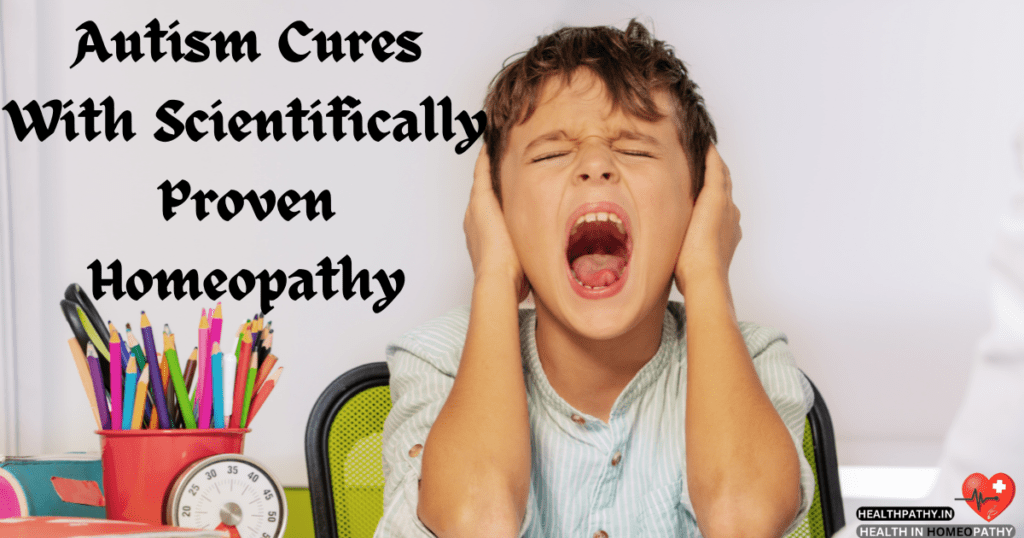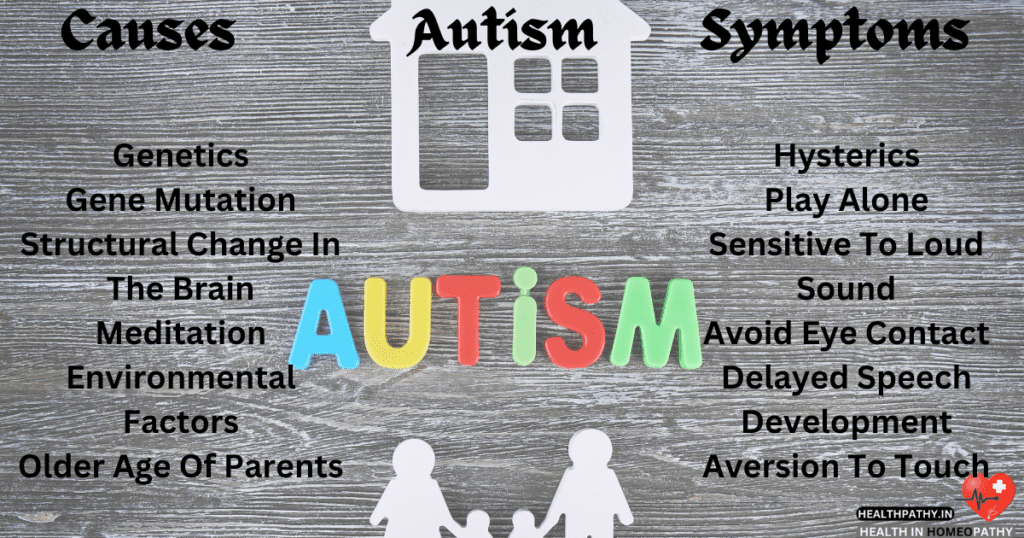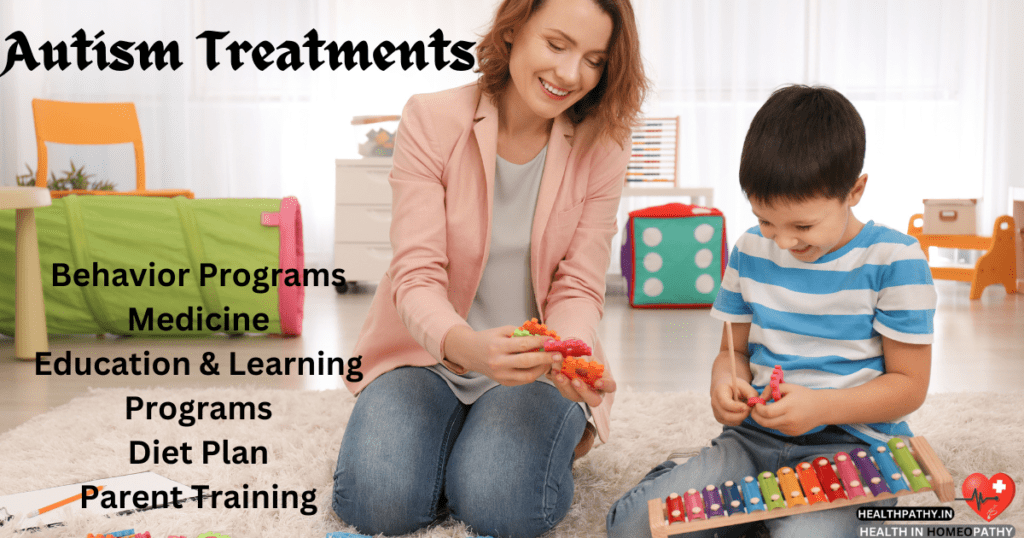Autism, often called Autism Spectrum Disorder (ASD), is a complex neurodevelopmental circumstance that affects a patient’s social skills, capabilities, communication competencies, behavior styles, and cognitive features. Autism Spectrum Disorder Cures With Scientifically Proven Homeopathy is characterized by using a spectrum of symptoms that can range broadly in severity and presentation, leading to unique challenges and strengths in affected people.
- Autism Spectrum Disorder Cures With Scientifically Proven Homeopathy
- Definition Of Autism:
- Causes Of ASD
- Types Of Autism
- Diagnosing Autism Spectrum Disorder (ASD)
- Signs & Symptoms Of ASD
- Diet For Autism
- Effective Homeopathic Cure
- Trusted Mother Tinctures Cure
- Other Safe Treatment Options
- The Power Of Do's:
- Mastering The Don'ts:
- Conclusion:
- FAQ
- Must Read:
- Must Watch:


Definition Of Autism:
Autism Spectrum Disorder is a lifelong situation that impacts how a person communicates with and pertains to others, in addition to how they perceive and interact with the world around them. It’s usually diagnosed in early childhood, manifesting in difficulties with social interplay, repetitive behaviors, limited interests, and challenges in verbal and non-verbal communication. This sickness includes a wide variety of symptoms, behaviors, and capabilities, emphasizing the term “spectrum” to renowned the range and individuality of those stricken by this circumstance. It’s important to approach everyone with autism holistically and know their unique desires and strengths.
Causes Of ASD
The reasons for autism spectrum disorder are complicated and multifaceted, often involving an aggregate of genetic, environmental, and neurological factors. Here are a few key elements associated with its causes:
- Genetic Factors: Genetics plays a widespread role in ASD. Research indicates that certain genes related to brain development and features can also contribute to an elevated likelihood of developing autism. However, no single gene has been identified as the only cause, suggesting a complex interplay of numerous genetic elements.
- Environmental Influences: Prenatal and early-lifestyle environmental factors may contribute to the development of autism. Factors consisting of maternal infections in the course of pregnancy, exposure to certain toxins or chemical compounds, complications during birth, and advanced parental age were studied as environmental effects.
- Neurological and Brain Development: Studies have proven that variations in brain structure and connectivity are located in people with ASD. These differences may also affect how records are processed and integrated inside the mind, contributing to the features, behaviors, and demanding situations associated with autism.
- Combination of Factors: It’s extensively believed that autism arises from an aggregate of genetic predispositions and environmental influences. Factors that impact brain improvement during critical periods in childhood might also engage with genetic vulnerabilities, contributing to the manifestation of ASD.
- No Single Cause: It’s essential to note that there may be no singular cause of autism, and the circumstance’s improvement is likely inspired by the aid of a complex interaction of genetic, environmental, and neurological factors that fluctuate from man or woman to character.
Types Of Autism
Understanding the diverse elements related to autism allows for shaping extra-complete processes to prognosis, remedy, and assist people on the spectrum.
Autism Spectrum Disorder (ASD) contains a spectrum of conditions, and at the same time as there isn’t a strict classification of types, the DSM-five (Diagnostic and Statistical Manual of Mental Disorders, Fifth Edition) outlines varying stages based on the severity of signs and the level of support wanted. Here are a few phrases used to explain special tiers on the autism spectrum:
- Level 1 – Requiring Support: This degree is characterized by mild signs and symptoms that could require a few guides. Individuals at this stage generally have important challenges in social communication but can function incredibly well in their daily lives. They may additionally struggle with social interactions, inflexibility in routines, and problems adapting to alternate.
- Level 2 – Requiring Substantial Support: At this stage, people show moderate signs and symptoms, requiring more substantial support in various regions. They can also have greater mentioned demanding situations in social communication, repetitive behaviors, and adapting to change. They may conflict with initiating social interactions and often exhibit restricted interest.
- Level 3 – Requiring Very Substantial Support: This stage includes severe symptoms that call for significant support. Individuals with Level 3 ASD may have vastly challenging situations in social communication, repetitive behaviors, and inflexible thinking. They may additionally show a minimum interest in social interactions, struggle immensely with alternates, and have problems functioning independently.
It’s important to notice that while these degrees are useful for diagnostic and help functions, ASD remains a spectrum ailment, and individuals may exhibit a wide range of abilities, strengths, and challenges no matter their assigned level. The focus must be on understanding the specific traits and needs of a person with autism instead of strictly categorizing them into types or levels.
Diagnosing Autism Spectrum Disorder (ASD)
Diagnosing Autism Spectrum Disorder (ASD) usually involves a complete evaluation with the aid of healthcare experts skilled in developmental disorders. Here are some of the key diagnostic assessments and tests generally used:
- Developmental Screening: Pediatricians regularly conduct developmental screenings during routine well-child visits to assess developmental milestones. Screenings like the M-CHAT (Modified Checklist for Autism in Toddlers) assist in discovering potential symptoms of ASD in young children.
- Comprehensive Developmental Evaluation: A more in-depth evaluation is conducted by a multidisciplinary team, including pediatricians, psychologists, neurologists, and speech-language pathologists. This evaluation entails staring at the child’s conduct, communication abilities, social interactions, and play patterns.
- Diagnostic Tools and Assessments: Diagnostic tools inclusive of the Autism Diagnostic Observation Schedule (ADOS) and the Autism Diagnostic Interview-Revised (ADI-R) are base checks that help clinicians compare and diagnose ASD primarily based on behavioral observations and caregiver interviews.
- Medical and Genetic Testing: Medical tests can be advocated to rule out other conditions that could present comparable signs and symptoms. Genetic checking out is probably conducted to identify genetic factors related to ASD in some instances.
- Other Assessments: Additional exams may also include cognitive checking out, speech and language assessments, sensory reviews, and behavioral checks to benefit a comprehensive understanding of the person’s strengths and challenges.
Diagnosing ASD involves an intensive evaluation, thinking about numerous aspects of the individual’s improvement and conduct. It’s essential to involve parents or caregivers in the diagnostic procedure to acquire a whole developmental history and behavioral observations across exceptional settings. Early prognosis permits early intervention and guidance, significantly improving consequences for people with ASD.


Signs & Symptoms Of ASD
Here are a few common signs and signs and symptoms associated with Autism Spectrum Disorder (ASD):
Social Challenges:
– Difficulty in understanding and responding to social cues, inclusive of facial expressions, gestures, and tone of voice.
– Struggles with developing and retaining relationships, making eye touch, or accomplishing reciprocal conversations.
– Difficulty in knowledge and expressing feelings or empathy towards others.
Communication Difficulties:
– Delayed or extraordinary speech and language development, consisting of echolalia (repeating words or phrases) or trouble in starting up or sustaining conversations.
– Challenges in knowledge of non-verbal verbal communication, like body language or facial expressions.
– Preference for the use of gestures or alternative verbal exchange methods over verbal language.
Repetitive Behaviors and Restricted Interests:
– Engaging in repetitive movements or behaviors, which include hand-flapping, rocking, or spinning objects.
– Strong adherence to workouts or rituals, resistance to changes in workouts, and a severe recognition of specific interests or subjects.
Sensory Sensitivities:
– Heightened sensitivity or uncommon reactions to sensory stimuli, including sensitivity to lighting, sounds, textures, or smells.
– Seeking or heading off certain sensory reports, like searching for deep strain or fending off sure textures.
Other Characteristics:
– Intellectual competencies can range broadly, from people with exceptional abilities in particular areas to people with intellectual disabilities.
– Unusual responses to social situations or environments, such as over or beneath-reactivity to sensory stimuli.
It’s important to notice that individuals with ASD can show an extensive range of behaviors, and every person’s experience is unique. Not all people with ASD will display a majority of these symptoms, and the severity of those developments can fluctuate notably among people. Early identification and personalized interventions can extensively aid people with ASD in managing demanding situations and enhancing their strengths.
Diet For Autism
It’s critical to word that whilst a diet plan does not directly treat Autism Spectrum Disorder (ASD), a few families select to discover nutritional changes to manipulate positive signs and symptoms. However, earlier than making any modifications, consulting with a healthcare expert, ideally a nutritionist or a dietitian skilled in working with people with ASD, is critical.
Gluten-Free and Casein-Free (GFCF) Diet: Some families discover casting off gluten (discovered in wheat) and casein (observed in dairy) from the food regimen, believing it might alleviate positive ASD signs and symptoms. However, medical evidence supporting this is restrained, and its effectiveness varies among people.
Balanced Nutrition: Emphasizing a properly balanced diet of fruits, greens, lean proteins, and whole grains is generally recommended. Omega-3 fatty acids found in fish, flaxseeds, and walnuts are believed to assist mental fitness.
Limiting Processed Foods and Sugar: Reducing processed meals and sugars is probably useful for some people with ASD, as they may be sensitive to positive meal components and artificial elements.
Effective Homeopathic Cure
Regarding homeopathic treatments, individualized treatment is critical in homeopathy. While several remedies are probably considered based on an individual’s particular signs and reactions, right here are five remedies that might be every so often mentioned with regards to ASD:
| Remedy | Indications |
| Carcinosin | Restless, hectic children with a record of developmental delays. The child is mid-yielding. Hyperactivity. Like artwork as drawing and singing. Affectionate, sympathetic. Child Is often slow but caring. Aggravation: change in weather, emotional pressure. Amelioration: calm and non-violent environments. |
| Stramonium | Fearful, nerve-racking, and aggressive behavior, in particular in the dark or by myself. Aggravation: Fearful conditions, darkness. Amelioration: Gentle handling, enterprise. |
| Aethusa Cyn | Symptoms of the brain and nervous system with gastro-intestine problems. Restless, anxious, uneasy, and violent. Inability to talk, to fix attention. Anguish, crying, uneasy. |
| Tuberculinum | Restless, impulsive, and hyperactive youngsters. Aggravation: Change in weather, pleasure. Amelioration: Open air, consistent alternate of hobby. |
| Hyoscyamus | Hyperactive conduct, restlessness, and impulsiveness. Low Muttering Speech, Very Suspicious, Talkative: Obscence, Jealous, Foolish. Great hilarity, inclined to laugh, deep stupor. Quarrelsome, uncover body. Aggravation: At night, after sleep. Amelioration: Sitting nonetheless, being watched or entertained. |
Trusted Mother Tinctures Cure
| Remedy | Indications |
| Passiflora Incarnata | Sometimes used for its calming property, specially for people experiencing restlessness, anxiety, or sleep disturbances. |
| Valeriana Officinalis | Known for its calming results and can be taken into consideration for individuals experiencing restlessness or sleep disturbances. |
| Scutellaria Lateriflora | Used for its ability calming outcomes on the nervous system, from time to time considered for individuals with anxiety or hyperactivity. |
| Avena Sativa | Known for its capability nervous system support and can be taken into consideration for its calming results. |
| Chamomilla | Sometimes used for its soothing residences, particularly in instances of irritability, restlessness, or digestive problems. |
It’s vital to reiterate that homeopathic remedies, together with mother tinctures, need to be prescribed by a qualified homeopath after a radical evaluation of the character’s symptoms and standard fitness. Additionally, it is critical to supplement any treatment technique for ASD with appropriate therapies and interventions recommended via healthcare specialists specialised in developmental problems. Always consult with a healthcare practitioner earlier than considering any new treatments or treatments.


Other Safe Treatment Options
Home treatments for people with Autism Spectrum Disorder (ASD) can complement different treatment procedures and offer guidance in handling certain symptoms. Here are a few techniques that some families find useful:
- Structured Routine: Establish a regular daily recurring to offer predictability and balance, which can help reduce tension and stress.
- Sensory Integration Activities: Engage in sensory-pleasant activities like sensory bins, swings, or activities that stimulate distinct senses to assist in regulating sensory processing.
- Visual Supports: Use visible aids, including photo schedules, social stories, or visible timers, to help with information and following routines and transitions.
- Mindfulness and Relaxation Techniques: Practice calming activities like deep respiration exercises, yoga, or guided relaxation to manipulate strain and tension ranges.
- Dietary Considerations: While diet plan doesn’t directly deal with ASD, a few families explore nutritional adjustments, which include gluten-loose or casein-unfastened diets. However, it’s vital to consult a healthcare professional before making vast nutritional changes.
- Nature and Outdoor Activities: Spending time exterior, playing nature, and engaging in bodily activities can assist in relaxation and sensory law.
- Social Skills Development: Encourage social interactions through playdates, organization activities, or based social talent-constructing packages.
- Therapeutic Supports: Consider complementary treatment plans like music therapy, artwork remedy, animal-assisted remedy, or occupational remedy to help sensory and emotional law.
- Limiting Stimuli: Create a calm and prepared environment by lowering immoderate noise, muddle, or overwhelming visible stimuli at home.
- Parent/Caregiver Support: Seek aid from determined assistance companies, workshops, or counseling to share reports and learn coping strategies.
Remember, every individual with ASD is particular, and what works for one man or woman may not be paintings for any other. It’s essential to tailor techniques to fit the specific desires and options of the person and consult healthcare experts for steering and aid.
From Do’s to Don’ts: Transforming Your Life for the Better
The Power Of Do’s:
- Be Patient and Understanding: Understand that each person with ASD is precise. Show endurance and empathy even as communicating or enticing with them.
- Use Clear and Concise Language: Use simple and direct language to bring data or commands. Speak frivolously and in reality to useful resource comprehension.
- Offer Predictability and Routine: Maintain an established ordinary and predictable environment, as people with ASD often feel more cozy with familiarity and predictability.
- Use Visual Supports: Utilize visual aids, together with pics, symbols, or schedules, to decorate verbal exchange and expertise.
- Provide Clear Instructions: Give unique, step-by-step instructions and be constant for your communication.
- Respect Sensory Sensitivities: Be conscious of sensory sensitivities and provide a sensory-friendly environment whilst viable.
- Encourage and Support Interests: Encourage and engage in activities associated with their interests, because it facilitates in building rapport and organising connections.
- Use Positive Reinforcement: Acknowledge and reward high-quality conduct to encourage repetition.
Mastering The Don’ts:
- Avoid Overloading with Information: Avoid overwhelming the individual with immoderate records or complicated commands.
- Don’t Assume Non-Responsiveness is Ignorance: Some individuals with ASD might have difficulty expressing themselves verbally. Lack of response doesn’t always imply lack of knowledge.
- Avoid Sudden Changes: Minimize sudden adjustments in exercises or environments, as it might purpose distress or tension.
- Avoid Using Sarcasm or Abstract Language: Individuals with ASD may warfare with information sarcasm, metaphors, or obstract language, so it’s first-class to apply direct and literal language.
- Don’t Force Eye Contact: Respect their comfort ranges with eye touch, as some individuals with ASD may also find direct eye contact uncomfortable.
- Avoid Sensory Overload: Be aware of loud noises, strong smells, or bright lights that could overwhelm sensory sensitivities.
- Don’t Interrupt Special Interests: Allow them to bask in their unique interests with out interruption except vital.
Remember, these guidelines are general and can vary depending on the man or woman’s preferences and needs. It’s vital to talk and have interaction with sensitivity, respect, and understanding. Consulting with experts or caregivers who recognize the person properly can offer treasured insights and guidance.
Conclusion:
“Autism Spectrum Disorder is a complex situation with a wide variety of signs and displays, impacting individuals uniquely. While the precise reason remains elusive, early diagnosis and intervention play a crucial function in enhancing outcomes. Understanding and guidance from households, educators, and communities are paramount in enabling individuals with ASD to thrive. By embracing diversity, selling reputation, and fostering inclusive environments, we will create a world wherein every character, regardless of their neurodiversity, is valued and empowered to attain their complete ability.”
Remember, helping individuals with ASD includes non-stop gaining knowledge of, empathy, and embracing differences to create a more inclusive and understanding society.
FAQ
Must Read:
Diabetes Mellitus Cures With Scientifically Proven Homeopathy
Constipation Cures With Scientifically Proven Homeopathy
Must Watch:
Homeopathy: The Green Medicine Of The Future
Homeopathy: Placebo or Real Medicine? | Homeopathy Is Not A Placebo | Is Homeopathy A Scam?
Friday 04 April 2025 5:30:37:PM
- Acromegaly Cures With Scientifically Proven Homeopathy - 8 February 2024
- Acidity Cures With Scientifically Proven Homeopathy - 1 February 2024
- Appendicitis Cures With Scientifically Proven Homeopathy - 27 January 2024


